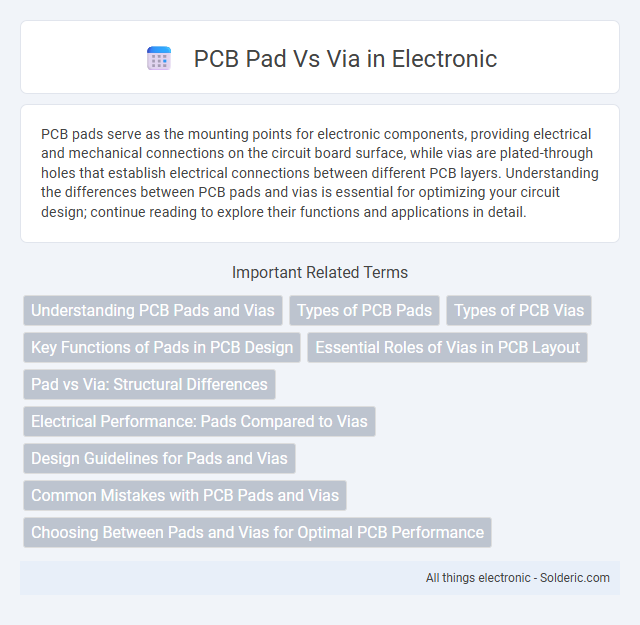PCB pads serve as the mounting points for electronic components, providing electrical and mechanical connections on the circuit board surface, while vias are plated-through holes that establish electrical connections between different PCB layers. Understanding the differences between PCB pads and vias is essential for optimizing your circuit design; continue reading to explore their functions and applications in detail.
Comparison Table
| Feature | PCB Pad | Via |
|---|---|---|
| Function | Provides soldering point for components | Connects different PCB layers electrically |
| Physical Structure | Flat copper area on surface | Cylindrical plated hole through PCB |
| Size | Larger surface area for component leads | Smaller hole diameter, compact |
| Types | Through-hole, Surface Mount | Through-hole via, Blind via, Buried via |
| Electrical Role | Supports component connection and heat dissipation | Enables multi-layer routing |
| Manufacturing Complexity | Simple copper etching and plating | Drilling and plating through-hole needed |
| Reliability | High mechanical strength for components | Potential failure if plating incomplete |
Understanding PCB Pads and Vias
PCB pads are flat, conductive areas designed to provide a surface for component soldering, ensuring reliable electrical connections. Vias are plated-through holes that electrically connect different layers within a multilayer PCB, facilitating signal and power routing between layers. Understanding the distinct roles of pads and vias helps optimize your PCB design for functionality and manufacturability.
Types of PCB Pads
PCB pads include surface mount device (SMD) pads, through-hole pads, and via pads, each serving specific connectivity functions on a printed circuit board. SMD pads are flat and designed for mounting components on the board surface, while through-hole pads have drilled holes for inserting component leads, providing mechanical stability and electrical connection. Via pads are circular copper areas surrounding vias, enabling signal and power routing between different PCB layers to maintain electrical continuity.
Types of PCB Vias
PCB vias come in several types, including through-hole vias, blind vias, and buried vias, each serving different connectivity purposes within multilayer circuit boards. Through-hole vias pass completely through the PCB, facilitating connections between all layers, while blind vias connect external layers to one or more inner layers without penetrating the entire board. Your choice of via type impacts signal integrity, manufacturing cost, and board space utilization in complex PCB designs.
Key Functions of Pads in PCB Design
Pads in PCB design serve as critical connection points for electrical components, providing mechanical support and ensuring reliable soldering during assembly. They facilitate the transfer of electrical signals between the component leads and the copper traces on the board's surface. Unlike vias, which primarily create electrical pathways between layers, pads are designed to secure components and maintain optimal electrical contact in your PCB layout.
Essential Roles of Vias in PCB Layout
Vias serve as critical connectors in PCB layouts, enabling electrical signals to traverse different layers efficiently and optimizing routing density. Unlike pads, which provide surface points for component attachment, vias facilitate multi-layer interconnections that enhance circuit compactness and reliability. Your PCB design benefits significantly from strategically placed vias, improving signal integrity and thermal management across complex board structures.
Pad vs Via: Structural Differences
PCB pads are flat conductive areas designed for component soldering and electrical connections on the surface, typically larger in size and shaped to accommodate component leads or surface-mount devices. Vias are small plated holes that create electrical pathways between different layers of a multi-layer PCB, enabling signal routing through the board's internal structure. Structurally, pads provide a stable mounting point on the outer layers, while vias serve as vertical conduits connecting internal layers, differing in both shape and function within PCB design.
Electrical Performance: Pads Compared to Vias
PCB pads provide superior electrical performance compared to vias by offering larger contact areas that reduce resistance and inductance, enhancing signal integrity. Pads support stable component mounting and reliable solder joints, which minimize the risk of electrical discontinuities under mechanical stress. In contrast, vias primarily serve as inter-layer connections with smaller cross-sectional areas, introducing higher impedance and potential signal degradation, especially at high frequencies.
Design Guidelines for Pads and Vias
Pads and vias play critical roles in PCB design, with pads providing component mounting points and vias facilitating electrical connections between layers. Design guidelines recommend pads to have appropriate size and shape to ensure reliable solder joints and component stability, while vias should be sized to maintain electrical integrity and manufacturability, often considering drill size, annular ring, and plating requirements. You must optimize pad and via dimensions according to industry standards like IPC-2221 to enhance signal integrity and manufacturability.
Common Mistakes with PCB Pads and Vias
Common mistakes with PCB pads and vias include improper pad sizing, which can cause poor solder joint reliability and electrical failures, and incorrect via placement that leads to signal integrity issues or mechanical stress. Using vias with insufficient annular rings often results in weak connections, while inadequate clearance between pads and vias may cause shorts during soldering. Overlooking thermal relief on pads around vias can also lead to uneven heat distribution and soldering defects.
Choosing Between Pads and Vias for Optimal PCB Performance
Choosing between PCB pads and vias depends on their distinct roles in circuit design and electrical performance; pads provide stable soldering surfaces for components, ensuring mechanical strength and signal integrity, while vias facilitate electrical connectivity between multiple PCB layers, affecting impedance and signal delay. Optimal PCB performance requires analyzing signal frequency, current capacity, and thermal management, with vias often used for multi-layer interconnections and pads for component mounting and external connections. Engineers prioritize pad size, via diameter, and plating type to minimize resistance, crosstalk, and potential signal loss, enhancing overall device reliability and efficiency.
PCB pad vs via Infographic

 solderic.com
solderic.com